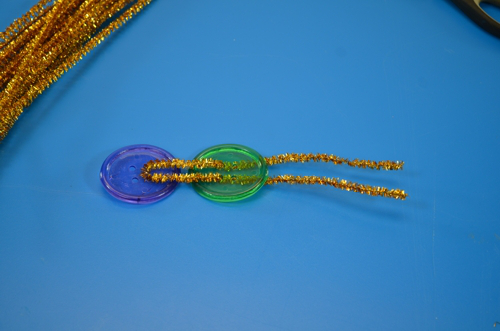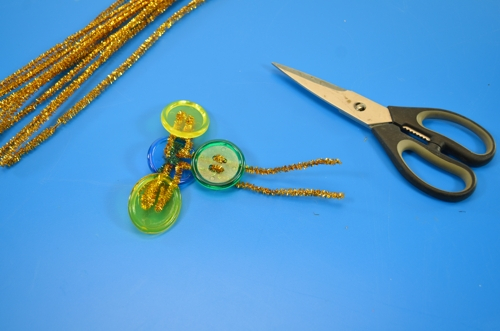
You’ll never need to swat these adorable button critters! Add them to any classroom for an extra Halloween edge.
Age: 4-7
Duration: 5-15 minutes (depending on the level of difficulty)
Learning Outcomes: Create adorable Halloween decorations. Practice fine motor skills.
You’ll Need:
- R20208 See-Through Big Buttons
- Chenille Stems
- Googly Eyes
- Glue

Today we’ll be walking you through three different bug crafts. Each craft is a varying level of difficulty. The heart-shaped spider is the simplest of the three crafts, followed by the beetle. The fly is the most challenging of the three.
We’ll start with the heart spider! You’ll need one heart-shaped button and four chenille stems. (You can use any shape button you want for the spider; we just liked how the heart looked!)

Fold each of your four chenille stems in half.

Put the ends of two of the chenille stems into two of the button holes.

Next put the ends of the last two chenille stems into the OTHER two button holes. Each button hole should have two chenille stems in it when you have completed this step.

All eight of the spider’s legs are now in place. Separate the chenille stems so they look like eight legs, and bend each stem twice. Once near the button, and once near the free end of the chenille stem.

You can choose the length of your spider’s legs. If you want shorter legs, trim off the excess “foot” on each leg. Once the feet are trimmed, use a dot of glue to add the eyes.

Let’s move on to the beetle! For this craft, you will need two oval buttons and three chenille stems.

Start by folding a chenille stem in half and threading it through two of the holes on the purple oval button.

Next, feed the ends of the chenille stems into two of the holes in the green oval button. The idea here is to make a beetle with some length, so make sure that you are using the sets of holes closest to the short ends of the ovals.

To fully secure the body, bend the chenille stems back towards the purple button, and up through the two free holes in the purple button. The loose ends will eventually form the beetle’s antennae.

Fold your remaining two chenille stems in half. Cut them so you have four half stems.

Fold each of your half stems in half again, but do NOT cut them. These will be your beetle’s legs. Insert the ends of the folded chenille stems into each set of holes in the buttons. We gave our legs a quick twist once they were through in order to secure them.

Once your beetle’s legs are secured, flip him right side up and fold some little feet for him.

The final steps are to add some curl to the antennae, and glue on some googly eyes!

Finally, we will make our button fly. For this project you will need four buttons. We used two ovals and two circles, but you can use any shapes you choose! You will also need 3 chenille stems.

Start by connecting the wings (yellow ovals) to the body (blue circle). Thread the body button onto the center of two chenille stems.

Thread two ends of the chenille stem into the set of holes farthest away from the edge of the yellow button that will be next to the blue button.

Thread the edges through the next set of holes, so the ends of the chenille stem are underneath the blue button. Your fly has one wing! Repeat on the other side to do the second wing.

Once your fly has both wings on, give the four loose ends of the chenille stems a twist to secure them and trim off any excess.

To attach the head, fold a chenille stem in half and insert the loose ends through two of the holes in the blue button.

Thread the loose ends of the chenille stems up through the first two holes of the green button and down through the second set.

Thread the loose ends up through the FIRST set of holes again. These will be your antennae, so give them a curl and add some googly eyes.

These bugs are great on their own, but they can also be strung on jewelry, hung from the classroom ceiling, or strung together to make a buggy garland!

Like us on Facebook, Share this post with your friends, or Subscribe to this blog today to receive original craft project updates every week
